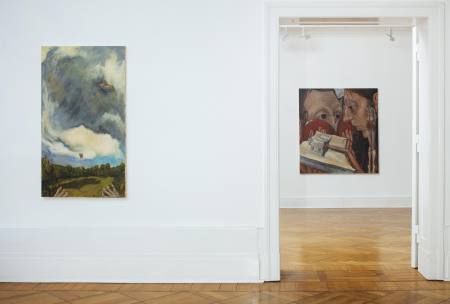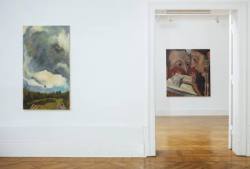Interface - Ausstellung Berlin

Ausstellung Galerie GNYP
Datum: 12.09.2025 - 25.10.2025
Künstler: Nour El Saleh
Veranstalter & Ort:
Galerie GNYP
10623 Berlin
Knesebeckstraße 96
You just arrived and don’t have your bearings, but that’s fine – we don’t either. Take these binoculars. Who’s that big, naked, long-fingered figure crouching on yonder hilltop? You can see others looking, too: someone throwing up, someone cowering but curious. Maybe, subjectively, you look from the creature’s perspective, making everyone here somebody’s other. And perhaps this all reminds you of something big but ungraspable, the prickly texture of being alive: questions on questions, fuzzy longings, glimpses of unnameable mystery, strangeness accepted because it’s right in front of you. Nour El-Saleh’s painting Spleen is, characteristically, a convocation of unanswerable queries: where, when, who, what level(s) of reality? (The exhibition title, Interface, might suggest the confected environments of video games.) All of this reflects, in turn, the fact that the artist only arrived shortly before we did. She almost always begins painting without knowing what she’s going to paint, working towards a heightened hinge zone where it’s clear something is about to happen, but not what.
Within all of this, some certainties. El-Saleh paints bodies in extremis, as if flesh were semaphoring inward emotional states, as if emotions reshaped physiognomy, sat literally close to the bone. Hands and feet, here, are as articulate and emphatic as eyes. Figures feel deeply, and sometimes we can intuit what: the relatable desire for change, mingled with fear of its consequences. Smaller figures, alternative selves perhaps, pop out of portals in skin (see Spoon-feed) or appear cradled in a bigger figure’s bony digits (sleepy lavender). In the reversible Fracture plane, a body transforms into a moth. In Flytrap, a moth-like human flies across the sky, like in a dream: to fall or soar or, the title hints, to be trapped after chasing light. Weather can feel like a character, an abstract cue. Part of El-Saleh’s skill is to withhold so much while beckoning viewers in, to teeter on narrative’s edge while affirming that audiences will never get the full story. There is a level specific to her Lebanese upbringing, easter eggs tucked into compositions that not everyone has the cultural heritage to access. But there are also clear signals of reception’s universal partialness – a reversible painting, for instance, can never be fully grasped – which turns viewers, collectively, into a community of the knowingly not-knowing, a condition those without faith might call the price of being alive. Art is where we voluntarily face and wonder about that, a conduit between here and the boundless unknown. Or, if you like, an interface.
Text by Martin Herbert
Within all of this, some certainties. El-Saleh paints bodies in extremis, as if flesh were semaphoring inward emotional states, as if emotions reshaped physiognomy, sat literally close to the bone. Hands and feet, here, are as articulate and emphatic as eyes. Figures feel deeply, and sometimes we can intuit what: the relatable desire for change, mingled with fear of its consequences. Smaller figures, alternative selves perhaps, pop out of portals in skin (see Spoon-feed) or appear cradled in a bigger figure’s bony digits (sleepy lavender). In the reversible Fracture plane, a body transforms into a moth. In Flytrap, a moth-like human flies across the sky, like in a dream: to fall or soar or, the title hints, to be trapped after chasing light. Weather can feel like a character, an abstract cue. Part of El-Saleh’s skill is to withhold so much while beckoning viewers in, to teeter on narrative’s edge while affirming that audiences will never get the full story. There is a level specific to her Lebanese upbringing, easter eggs tucked into compositions that not everyone has the cultural heritage to access. But there are also clear signals of reception’s universal partialness – a reversible painting, for instance, can never be fully grasped – which turns viewers, collectively, into a community of the knowingly not-knowing, a condition those without faith might call the price of being alive. Art is where we voluntarily face and wonder about that, a conduit between here and the boundless unknown. Or, if you like, an interface.
Text by Martin Herbert
Ads
weitere Ausstellungen von GNYP

29.11.2025 - 31.01.2026
Challenge

12.09.2025 - 25.10.2025
Interface

27.06.2025 - 02.08.2025
We Have No Troubles Here

02.05.2025 - 21.06.2025
Les choses de la vie (the things of life)

14.03.2025 - 26.04.2025
I Pictured Skin